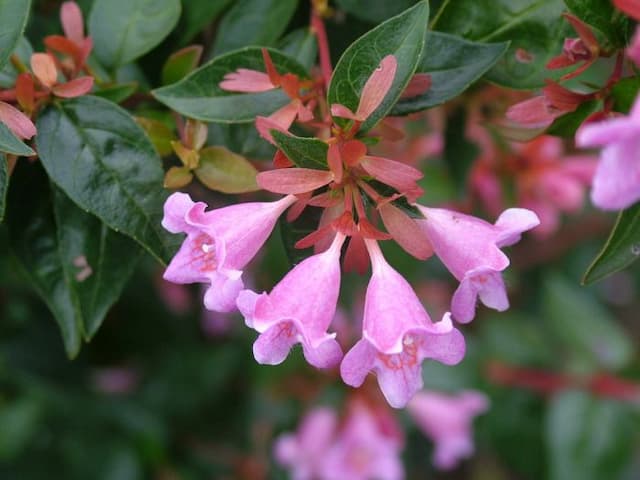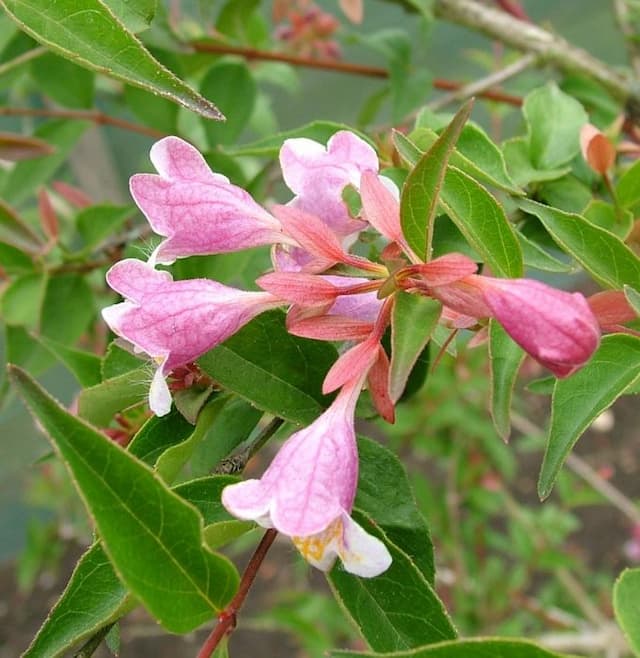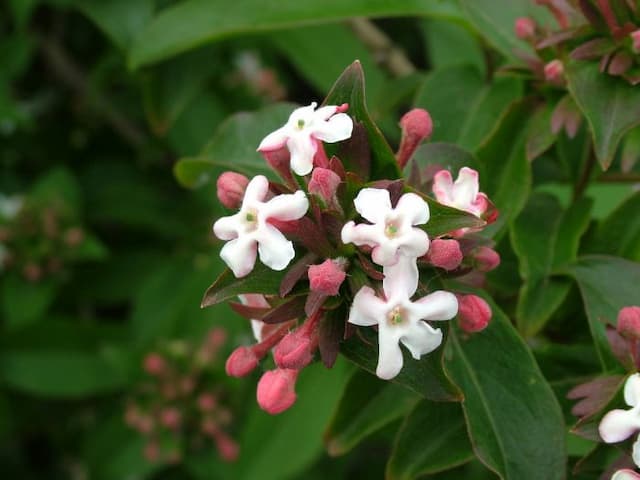Variegated Weigela Weigela 'Nana Variegata' (v)

ABOUT
Weigela 'Nana Variegata' is a decorative shrub that displays a multitude of attributes, making it a visually appealing choice for gardeners. This plant boasts a striking variegation in its foliage, with leaves that have a distinctive edge of creamy-white bordering a green center. This color contrast adds a sense of depth and brightness to wherever the plant is situated. When in bloom, Weigela 'Nana Variegata' comes alive with a show of trumpet-shaped flowers. The blossoms are typically a soft pink to rose color, complementing the variegated leaves beautifully. These flowers emerge in abundance, often covering the plant in a blanket of color that is both eye-catching and enchanting. The overall form of this variety is somewhat rounded and bushy, contributing to its lush appearance. The branches tend to arch gracefully, which allows the variegated leaves and flowers to drape elegantly and adds a sense of movement to the plant's structure. This combination of colorful foliage and abundant blooms make the Weigela 'Nana Variegata' a standout specimen in any garden setting.
About this plant
 Names
NamesSynonyms
Dwarf Variegated Weigela, Variegated Weigela.
Common names
Weigela florida 'Variegata Nana', Weigela florida 'Nana Variegata'.
 Toxicity
ToxicityTo humans
Weigela is generally not considered toxic to humans. There is no information suggesting that ingestion of this plant causes poisoning in humans, and it is generally understood to be safe around adults and children in a garden setting. Consequently, there are no specific symptoms associated with poisoning from this plant, as it is not known to be poisonous.
To pets
Weigela is not known to be toxic to pets either. It is typically considered safe for dogs, cats, and other domestic animals, and there are no well-documented cases of poisoning from ingestion of this plant. Therefore, pet owners typically do not need to worry about toxicity symptoms from their pets ingesting Weigela.
 Characteristics
CharacteristicsLife cycle
Perennials
Foliage type
Deciduous
Color of leaves
Variegated
Flower color
Pink
Height
2-4 feet (0.6-1.2 meters)
Spread
2-4 feet (0.6-1.2 meters)
Plant type
Shrub
Hardiness zones
4-8
Native area
Asia
Benefits
 General Benefits
General Benefits- Attractive Foliage: Variegated leaves add visual interest to gardens with their blend of green and white or cream-colored patterns.
- Spring Blooms: Produces pink to red trumpet-shaped flowers that add a pop of color in late spring and can attract pollinators like bees and hummingbirds.
- Compact Growth: As a dwarf variety, it's well-suited for small gardens or spaces where a smaller stature plant is desired.
- Deciduous Nature: Offers seasonal change, with foliage that adds autumnal charm as leaves change color before dropping in the fall.
- Low Maintenance: Requires minimal pruning and is generally easy to care for once established, making it ideal for gardeners of all skill levels.
- Drought Tolerance: Once established, it can tolerate periods of dryness, reducing the need for frequent watering.
- Cold Hardy: Can survive in cold temperatures, making it suitable for planting in various climates without requiring winter protection.
- Versatility: Can be used in mixed borders, as a stand-alone specimen, or in foundation plantings, providing flexibility in landscape design.
- Wildlife Friendly: Attracts beneficial insects and serves as a food source for some wildlife, contributing to biodiversity in the garden.
 Medical Properties
Medical PropertiesThis plant is not used for medical purposes.
 Air-purifying Qualities
Air-purifying QualitiesThis plant is not specifically known for air purifying qualities.
 Other Uses
Other Uses- Living Fences: Weigela can be used to create a living fence or privacy screen due to its dense foliage and bushy habit.
- Topiary Art: With regular pruning, Weigela can be sculpted into various shapes for topiary art in gardens.
- Erosion Control: Planted on slopes, Weigela helps to prevent soil erosion with its root system.
- Butterfly Garden: Weigela attracts butterflies, making it a great addition to butterfly gardens for enthusiasts and photographers.
- Sound Barrier: The dense growth of Weigela can help dampen noise when planted along the perimeter of a property.
- Photography Backdrops: The colorful foliage and flowers of Weigela make it an excellent backdrop for outdoor photography.
- Seasonal Arrangements: The branches, when laden with flowers or with variegated leaves, can be clipped and used in floral arrangements.
- Garden Themes: Weigela is suitable for planting in themed gardens, such as Victorian or cottage gardens due to its classic appearance.
- Wildlife Habitat: Weigela shrubs provide shelter and nesting sites for birds within a garden ecosystem.
- Winter Interest: Some Weigela varieties have interesting stem coloration or structure that adds visual interest to the garden in winter.
Interesting Facts
 Feng Shui
Feng ShuiThe Weigela is not used in Feng Shui practice.
 Zodiac Sign Compitability
Zodiac Sign CompitabilityThe Weigela is not used in astrology practice.
 Plant Symbolism
Plant Symbolism- Adaptability: Weigela is known for its ability to adapt to different soil types and environmental conditions, symbolizing flexibility and resilience in various situations.
- Victorian modesty: In Victorian times, flowers often represented different virtues, and weigela, with its humble appearance, might be associated with the modesty of an unassuming character.
- Overflowing Abundance: With its prolific blooms, weigela can symbolize an overflow of feelings or abundance, suggesting a generosity of spirit or emotion.
- Spring Renewal: As a plant that flowers in spring, weigela is symbolic of renewal and the beginning of new phases, mirroring the regeneration in nature.
 Water
WaterVariegated Weigela should be watered deeply and thoroughly, ensuring the water reaches the roots. For young plants, watering twice a week during hot and dry conditions is recommended, decreasing to once a week as the plant becomes established. Typically, one to two gallons per watering session should be sufficient, allowing the soil to dry out slightly between waterings. During the winter months or in cooler weather, reduce watering frequency to reflect decreased evaporation and plant uptake.
 Light
LightThe ideal lighting condition for Variegated Weigela is full sun to partial shade. It thrives when it receives at least 6 hours of direct sunlight daily, but some afternoon shade can be beneficial in hotter climates. An eastern or western exposure providing bright, indirect light for part of the day is also suitable for this plant.
 Temperature
TemperatureVariegated Weigela prefers a temperate climate and can tolerate a temperature range from 20°F to 85°F. However, its ideal growing temperature is between 50°F and 75°F. While it can survive brief periods outside this range, extended exposure to temperatures beyond this spectrum can cause stress to the plant.
 Pruning
PruningPruning Variegated Weigela is done to shape the plant, remove dead or diseased branches, and promote more prolific blooms. The best time to prune is immediately after the spring flowering has finished. Generally, pruning can be performed annually or biennially, depending on the desired plant size and shape.
 Cleaning
CleaningAs needed
 Soil
SoilWeigela 'Nana Variegata' prefers well-drained soil rich in organic matter with a slightly acidic to neutral pH level, ideally between 5.5 and 7.5. The best soil mix can be achieved by combining garden soil, compost, and peat moss to enhance fertility and drainage. It's also beneficial to incorporate a slow-release fertilizer into the soil mix at planting time.
 Repotting
RepottingWeigela 'Nana Variegata' is typically not grown in containers and hence does not require regular repotting. However, if you must grow it in a pot, repotting can be performed every 2 to 3 years or when the plant outgrows its current pot, using a fresh soil mix as described for ideal growth.
 Humidity & Misting
Humidity & MistingWeigela 'Nana Variegata' is adaptable to a wide range of humidity levels and does not require specific humidity conditions. It thrives in outdoor garden environments where the natural humidity is sufficient for its growth.
 Suitable locations
Suitable locationsIndoor
Variegated Weigela needs bright indirect light indoors.
Outdoor
Plant in sun to part-shade in well-drained soil.
Hardiness zone
4-8 USDA
 Life cycle
Life cycleWeigela 'Nana Variegata', commonly known as Dwarf Variegated Weigela, begins its life cycle when a seed germinates, typically in spring, in well-drained soil with full sun to partial shade exposure. The seedling grows into a young plant, developing a woody stem and distinctive variegated leaves, with creamy white margins and green centers. As the plant matures, usually within 2-3 years, it reaches its flowering stage, which occurs in late spring to early summer, producing funnel-shaped pink flowers attractive to bees, butterflies, and hummingbirds. After pollination, the flowers give way to inconspicuous fruit capsules containing seeds, completing the reproductive cycle. Throughout its life, which can span many years with proper care, the Dwarf Variegated Weigela undergoes periodic growth and dormancy cycles, with active growth in the spring and summer and dormancy in the fall and winter. Pruning immediately after flowering can encourage a second bloom and maintain the plant's shape.
 Propogation
PropogationPropogation time
Spring-Early Summer
The Weigela ‘Nana Variegata’, commonly known as Variegated Dwarf Weigela, is typically propagated through softwood cuttings taken in late spring to early summer. This method involves cutting a 4 to 6-inch (10 to 15 cm) length of stem from new growth that has not yet hardened and is still flexible. The leaves on the lower half of the cutting should be removed, and the cut end may be dipped in rooting hormone to encourage root development. The prepared cutting is then planted in a well-draining soil mix and kept in a warm, humid environment with indirect light until roots have developed, which can take several weeks. To maintain humidity, a plastic bag or cover can be placed over the cutting, but it should be removed periodically to allow for air circulation and prevent mold growth. Once rooted, the new Weigela can be transplanted to a more permanent location.







![Himalayan honeysuckle [Golden Lanterns]](/_next/image?url=https%3A%2F%2Fplants-admin.emdemapps.com%2Fimages%2Fplants%2F%2Fimages%2F604b55302cc87.png&w=640&q=75)

